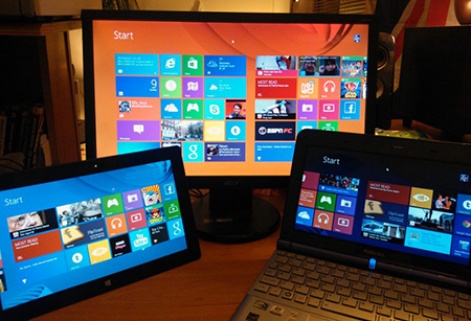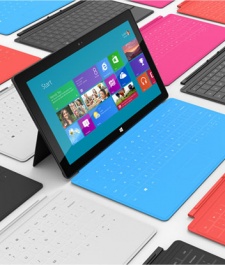When I was hunting for the flat I later moved into that's in Manchester, England if you're looking for a needy games journo to stalk furnished apartments were something of a rarity. Most were, like mine, vast empty spaces waiting to be loved.
However, given I was moving from a shared house, the lack of fully kitted out pads was rather frustrating at the time I had no real furniture to call my own, and my first few weeks in my abode were rather barren ones.
However, months down the line, I was glad of it: starting with a completely blank canvas meant everything within my walls was something I'd purchased, and therefore meant something to me.
It was genuinely my apartment a reflection of my likes, my passions and...well, my junk.
Now, as I browse the renting ads again, things seem to have flipped, and empty apartments are the ones that are now few and far between. Almost every flat I've seen advertised comes 'ready made': stuffed with the generic belongings someone else picked up on the cheap from IKEA.
If you're not sure where I'm going with this, let me save you some time: For the purposes of this piece, Surface is an empty flat, and iPad a fully furnished one.
Starting afresh
Contrary to the opinion of much of the press, I'm not talking about the comparative sizes of both platform's relative app stores.
No one can compete with iOS on that score, but in truth, Windows Store is the most populated app store I've seen of any new platform at this stage particularly when it comes to social apps.
Rather, what I'm suggesting is, Surface feels like that same blank canvas my apartment was on day one. Apple's iPad, in comparison, feels like it's good to go straight out of the box.
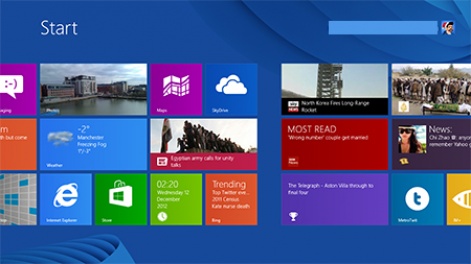
Surface's Start screen: Alive and kicking, providing you play ball
To put it another way, Microsoft's only comes alive when users plug their personalities into it. Left to its own devices, it's a plain, almost unassuming entity.
There are obvious advantages and disadvantages to this approach, of course both of which may result in the developers who have already taken to Microsoft's new either making a whole lot of money, or in a worst case scenario losing quite a bit instead.
Less than a week into my Surface experience, I can say it's already surpassed my rather high expectations.
It's no secret that I'm a fan of the Metro UI, and Surface and Windows 8 as a whole is the perfect realisation of the personal, social platform Microsoft set out to deliver two years ago with Windows Phone 7.
Within a few hours, I'd plugged all my various social networks into the OS, download scores of social apps, and populated my start screen with so many live tiles, it warrants coming with an epilepsy warning.
This is both Surface's greatest strength and potentially its most damaging weakness, however. What I've noticed of late is, my Start screen doesn't look anything like those sported by the Windows 8 demo units you'll see flashing away in your local electronics retailer.
Microsoft needs YOU
It's an obvious hurdle when you think about it.
As flash and interactive as Surface's Start screen looks, it only comes alive when you invest in it: when you download apps that either tap into your presence on the web, or install games released by developers canny enough to realise the opportunities live tiles present.
Yippee Entertainment's Chimpact, for instance, uses its live tile to engage its audience.
Rather than simply sitting static on your start screen, the Chimpact tile starts flashing stats at you detailing your performance and progression every so often, almost beckoning you to give it a tap and have another go.
Indeed, when you're sat amongst a stream of app tiles flipping over and beaming out information, it's essential that your app doesn't get left behind. Surface's Start screen is a shop shelf all of its own.
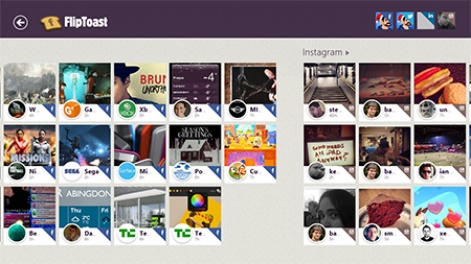
Fliptoast - One of many social aggregation apps, neatly combining Facebook, Twitter, LinkedIn and Instagram feeds
Sadly, however, there's no way of conveying this level of interactivity and personalisation on a demo unit.
Yes, Microsoft has built glossy videos that show off the UI into its Windows 8 demo pods, and there are generic pictures, emails and notifications aplenty from especially good looking 'friends' that populate the screen should you actually play with it, but they struggle to convey the platform's key selling point.
Namely, that both new Windows platforms deliver entirely individual experiences for each and every person that uses them.
Been there, done that
It's not as if Microsoft hasn't encountered these kind of hiccups before.
When Nokia launched its first Windows Phone handsets to much fanfare, demo handsets started popping up in mobile retailers across the UK.
Indeed, it would appear Nokia spent quite a lot of money securing prominent spots in major mobile chains, with the Finnish firm's range of Lumia phones flashing away at passers by just as Windows 8 devices do now.
But, have you ever tried playing with one of those demo units? They're utterly bland full of blank, empty tiles that make the OS look utterly lifeless and impenetrable.
In fact, chances are someone will have tampered with it minutes before you come along, altering all the shapes and sizes of the tiles and moving them around to form a bizarre and often incomprehensible mess.
For anyone unfamiliar with Metro, those demo handsets likely confuse more people than they inform. I don't have any stats to hand, but it's hard to imagine all too many Lumia owners picked up their handset based on their in-store experience alone.
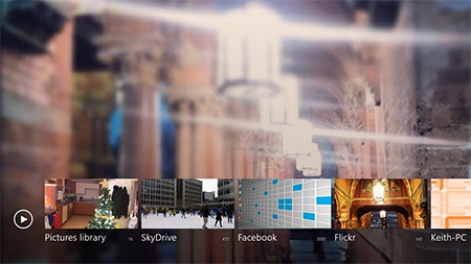
Surface's slick Photos hub seamlessly integrates with Facebook, Flickr, SkyDrive and any other Windows devices via HomeGroup - providing you tell it to, of course
In comparison, both iPhone and iPad alike deliver a user experience that most consumers now know like the back of their hand - a UI that, though comparatively plain, delivers an image of stability and safety.
It's an experience that, combined with Apple's advertising prowess, means your average phone shop salesman doesn't have to try all too hard to sell an iOS device or two.
Heavy lifting
This is, of course, by no means a killer blow to Microsoft's tablet.
Launch figures may be under wraps, but it's safe to assume that Windows 8 as a whole already boasts a fairly healthy userbase due to the standard roll out of PC upgrades and corporate contracts.
Microsoft's theory is, once users become accustomed to the new user experience on their own PCs, Metro will become just as familiar as iOS at retail level.
That's going to take some time to take effect, however - if, indeed, it ever does. It's not hard to see why Microsoft has, until now, restricted Surface to online sales only, or the carefully controlled environment of its own stores in North America.
Sales so far have been to the die hard fans and the curious. When sat next to the latest iPad and high-end Android tablets on the shop shelves, however, Surface is going to find it far harder to compete for attention.
Just like those who can't pictures themselves in an empty apartment until they've moved in, it's unlikely consumers used to the 'rows-of-apps' approach so mastered by Apple will be temped to try something that only comes to life when they take it home and engage with it.
Let me be clear: My opinion of the new Windows platform hasn't changed. Both Windows 8 and Windows RT deliver the kind of innovation the tablet and PC markets have been calling out for.
But when people are so used to having everything handed to them on a plate, it's not going to be easy for Microsoft to persuade them to do some of the heavy lifting themselves, however rewarding the results may be.
